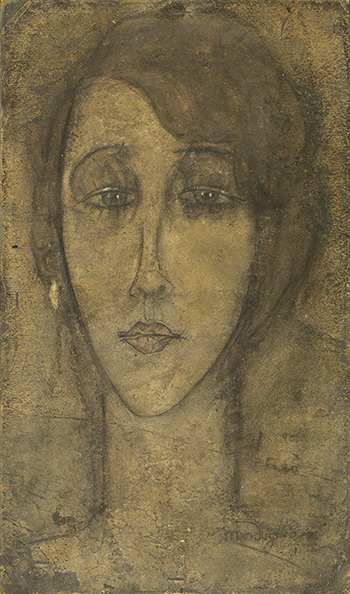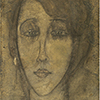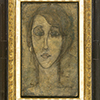PROVENANCE:
Acquired directly from the artist
Madame L. Charpentier, Paris, 1919-1937
Madame Ribas, Barcelona Emilio Ribas, 1937-app. 1966
Welters van Hattum, Dutch collection, Vice Consul of the Netherlands from app.1968
Private collection, Europe (from the late 1970s till now)
EXHIBITED:
Works by Amedeo Modigliani in Dutch Possession , Centraal Museum Utrecht, Netherlands, March 15-May 5, 1968
ILLUSTRATED:
Works by Amedeo Modigliani in Dutch Possession , Centraal Museum Utrecht, Netherlands, 1968, no.3, pp.14-15
Collection Welters van Hattum , Netherlands, no. 3
This work is to be sold with a certificate of Jean Cocteau signed in 1961 and as well as a certificate of authenticity signed by Arthur S. Pfannstiel, the expert for Modigliani’s art in 1966.
Catalogue Note:
The twentieth century, a group of artists gradually settled in the Montparnasse region, forming a new artistic settlement based on café studios such as The Bee Hive (La Ruche), The Rotunda (La Rotonde), The Dome Le Dôme), and The Circle of Lilacs (La Closerie des Lilas). After 1909, Modigliani moved there and got to meet many artists from the Paris School (École de Paris), including Picasso, Brâncuşi, Sou tine, Kisling, Léonard Tsugouharu Foujita.
The spring in 1917, the handsome artist Amedeo Modigliani, the Prince of Montparnasse, met his Muse, Jeanne Hébuterne. That summer, his dear painter friend, the King of Montparnasse, Moïse Kisling, married his Queen, Renée Kisling. From brothels and cafés to artists’ studios, the whole of Montparnasse held a three-day celebration for the newlyweds.
The bride was from a cavalry family. In 1916, she studied at the Académie Ranson and joined the circle of the avant-garde Ecole de Paris. Young and free, Renée in the Montparnasse, stewing in an atmosphere of art, was like a fish in water. She was among the first women in Paris to wear men’s casual pants, and she wore her blond hair short. Her unpretentious personality and her signature broad smile made her popular. Participating in an unrestrained life, she also used a camera to record the features of the Golden Age. She and her husband were both great hosts. Loving friends and good food, they constructed a social life centered on their family, and what Renée hated most were guests who left early and the end of a party.
Kisling once commented, “It is peculiar. I immediately fell for her short hair, large nose, and pointed chin. Her face was not exactly beautiful, but it revealed a smart and sensitive disposition.” Between 1916 and 1928, Kisling painted a series of portraits of his wife with almond eyes. Around 1917, Modigliani, who was so close to Kisling that they shared a studio and their models, painted three sketches and two oil paintings of Renée. One of the oil paintings, titled “Renée”, is now in the collection of the São Paulo Museum of Art in Brazil. The crimson background brings out the figure with blond hair and blue eyes. The figure has a long neck, thick lips, and a straight nose. Red highlights her white cheeks. Her necklace, with a golden cross at the collarbones, is the visual center.
The auction piece is Portrait d’une Dame (Renée). This work exhibits a style similar to that of the oil painting in the museum collection in Brazil. Art expert Arthur S. Pfannstiel has certified that this piece was created by Modigliani between late 1916 and early 1917, with gouache on hard paper sketching board. Below the artist’s signature on the right is the note “Renée”. A friend of the two artists, French poet Jean Cocteau, also signed a certificate in 1961 to guarantee that he had seen the painting composed like this piece in Kisling’s studio. The face of the central figure occupies the whole picture. She has curly short hair and gentle eyes, and the composition of the long lashes and shiny eyes is very clear. The figure in the picture gazes at the viewer’s soul, and she has witnessed the sparks of the avant-garde Paris and the Italian classical tradition inspired in Modigliani.
This artwork is from the collection of the Spanish Ribas-Vila family, their family member Mme Vve. Ribas-Vila was friends with Modigliani's neighbor Mlle. Charpentier, when they lived at no. 8 rue de la Grande-Chaumière. Mlle. Charpentier was a friend of the artist, she had often visited him and provided financial assistance when he was alive. In the property of Mlle. Charpentier, there was a set of artworks given to her by the artist himself. In 1968, Vice Consul of the Netherlands Welters Van Hattum, bought this set of artworks and became a collector with one of the biggest collection of Modigliani works in Europe at the time. Later, the collection was exhibited at the Centraal Museum in Utrecht, Netherlands and it had caused quite a stir at the time.
The topics of Modigliani's creations were almost always females, were sculpted or painted. There are only four existing landscape paintings. All the rest are portraits of people he saw in his life, including models, friends, and his lover Jeanne, both clothed and Nity. As for his style, he mixed the Western tradition with multiple cultures, especially his love for the traditional classical Italian style. His inspiration also came from Cézanne, the Pre-Raphaelites, Renaissance paintings, Cubist paintings, African sculpture, Cambodian reliefs, and Japanese prints. He transferred his study of sculpture to paintings, surgical the depiction of muscles and instead searching for a simplified style that expressed the internal forms. All of the subjects of Modigliani's work - whether men or women - display a certain sensitive femininity. The figures' lines of the sight of the lack of focus, showing confusion and apathy in the eyes, as if not seeing the external world. Modigliani had a deep influence on the early Chinese artists who studied in France. Sanyu, Pan Yuliang, and Lin Fengmiang's paintings of human figures were conducted inspired by Modigliani. Modigliani's influence can still observed in portraits by many contemporary artists today.


